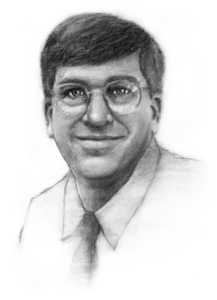 |
|
|||||||||
|
Tune in, turn on Greg Jackson, vice president and chief information officer, oversees the University’s information-technology resources—computer hardware and software, e-mail, networks, and phones. He came to Chicago from MIT in 1996 as associate provost for information technology; before MIT he taught at Stanford and spent 11 years at Harvard, teaching and as a technology consultant.
Chicago’s Networking Services and Information Technologies, which Jackson runs, has a $70 million annual budget and a 300-person staff. Between managing daily crises—viruses, worms, and system-clogging movie downloads—Jackson focuses on a larger goal: advancing academic life through technology. What are the financial
priorities for the University’s electronic resources? The interesting priorities more directly involve the University’s core missions: teaching students and advancing knowledge. Although most research technology is managed at the departmental or lab level, instruction is a central priority: we invest in systems to help faculty organize and deliver teaching materials over the network and to increase the use of multimedia. We also create learning spaces such as media classrooms and student computing clusters. What are some of the academic
tasks students can now do online? Recently we’ve seen more use of multimedia—both through Chalk, where faculty make class materials and discussion groups available to students, and in students’ own work, which increasingly includes movies, live links, and other things my college papers never had. We have high demand for multimedia equipment and help. The Library also has expanded its electronic resources dramatically—online journals, an online catalog with live links, scanned images of rare materials, you name it. What kinds of tasks can
students look forward to doing online in the future? How much activity does
the system see? How does Chicago keep up
with increasing demand? The real issue concerns increased off-campus traffic, for which we have to buy expensive capacity. In the past several years we’ve more than quadrupled the capacity of the commodity Internet connections, meaning everything but research connections. Those connections cost us about $400,000 a year, and we keep needing more. Although some commodity traffic benefits the University directly, a lot is people moving movies around, sharing music, or gabbing with friends. It’s harder to argue that we should be spending money for that, but there’s no easy way to separate entertainment from work. How many hacker attacks
does the network receive? How do you combat them? Major new attacks, on the other hand, come at a rate of about two a month. There were six or seven over the summer, for example. Blaster is one, Nachi is another, the I Love You virus was further back. Nachi and Blaster cost us about $400,000, mostly in paying staff to scratch and restore computers. To combat attacks we first try to educate people to keep up antivirus software, to not run unnecessary services, to not let their kids install games they’ve never heard of. Those things can open up vulnerabilities. We also do an enormous amount of intrusion detection. We have listening posts scattered over the network, watching for abnormal activity. They’ll zero in on where such activity is coming from, and we’ll take a close look at the offending machine from the network. If the activity matches a known pattern of compromise we’ll pull the machine off the network. We pull about 100 machines off the network every week this way. If it’s a really dangerous vulnerability we’ll pull machines off the network before they get infected. If someone’s machine is compromised again and again, he or she will be called in for a conversation with a dean or a boss. Have people ever tried
to break into the system to, say, change a grade? Where on campus is there
wireless access? What is the University’s
policy for downloading music and movies?
|
|
Contact
|


